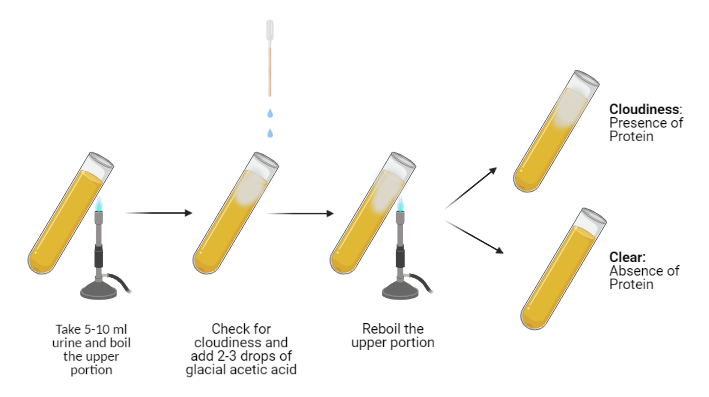Most plasma proteins are too large to pass through the glomeruli of the kidney. The small amount of protein which does filter through is normally reabsorbed back into the blood by the kidney tubules. Only trace amounts of protein (less than 150 mg per 24 h) can therefore be found in normal urine. These proteins include Tamm-horsfall protein (Maximum-40%), Albumin (20%), Immunoglobulins, Hormones, Enzymes and Mucopolysaccharides.
When more than trace amounts of protein are found in urine, this is termed proteinuria. Detection of proteinuria is an important indicator of renal disease because protein has a very low maximal tubular rate of reabsorption. The following methods are used to test for proteinuria:
Qualitative Tests:
- Heat and acetic acid test
- Sulphosalicyclic acid test
- Hellers nitric acid test
Quantitative Tests:
- Esbach’s method
- Aufrecht’s method
Other tests:
- Protein reagent strip test
- Biuret test
- Urine protein electrophoresis
Heat and acetic acid test
Principle:
This test is based on the principle that proteins get precipitated when boiled in an acidic medium.
Procedure:

- Take 5-10ml clear urine in a test tube.
- Boil the upper portion over a flame.
- Compare the heated part with the lower part. Cloudiness or turbidity indicates the presence of either proteins or phosphates/carbonates.
- Add 2-4 drops of 10% glacial acetic acid and boil the upper portion again.
- If turbidity is still present, protein is present in urine. If turbidity disappears, that is due to phosphates or carbonates present in urine.
Result and Interpretation:
Grade the turbidity as follows:
- Negative : No cloudiness
- Trace: Barely visible cloudiness.
- 1+ : definite cloud without granular flocculation
- 2+ : heavy and granular cloud without granular flocculation
- 3+ : densed cloud with marked flocculation.
- 4+ : thick curdy precipitation and coagulation
References
- Sood R. Concise book of Medical Laboratory Technology. Jaypee Brothers Pvt. Limited; 2015.
- Cheesbrough M. Medical laboratory manual for tropical countries. M. Cheesbrough, 14 Bevills Close, Doddington, Cambridgeshire, PE15 OTT.; 1981.

Be the first to comment